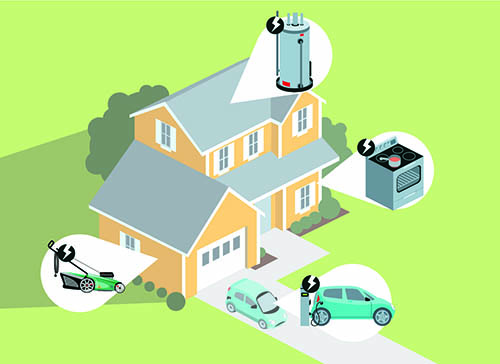Do you enjoy waking up to the rumble of your neighbor’s lawn mower on a Saturday morning? The days of mowers and other devices making a rumbling noise and spewing exhaust into the air may be coming to an end.
The concept, known as “environmentally beneficial electrification,” is gaining traction among a growing number of groups in the U.S. including local electric cooperatives. Frequently promoted as a means to reducing greenhouse gases and helping the environment, beneficial electrification also helps consumers by providing products that are cleaner, quieter and easier to maintain.
 Beneficial electrification is a departure from the conventional wisdom, which held that appliances fueled on-site, like natural gas water heaters, were more efficient and easier on the environment. The natural gas industry argues that generating and distributing electricity is less efficient than burning fuel on-site.
Beneficial electrification is a departure from the conventional wisdom, which held that appliances fueled on-site, like natural gas water heaters, were more efficient and easier on the environment. The natural gas industry argues that generating and distributing electricity is less efficient than burning fuel on-site.
But that old argument is crumbling, and one of the biggest drivers of this trend is the flexibility of the electric grid itself. As utilities shift to renewable technologies and make existing generation technologies cleaner, electricity uses less fossil fuel per kilowatt-hour of energy produced. Electric appliances become “greener.” Electric appliances themselves are also becoming more efficient due to technological improvements and increased government standards, and gas appliances aren’t keeping up.
“Over their life, electric products can support the integration of renewable energy generators, on-site renewable generation, and thermal and battery storage programs. The same cannot be said of appliances that require fossil fuel on-site,” says Keith Dennis, NRECA senior principal of end-use solutions and standards. “This applies to electric vehicles, systems that heat and cool homes and many other end-use technologies.”
So, what will change around the home and how will it impact you? Four changes you’re likely to see are to your water heater, stove tops, lawnmowers and vehicles. First, hybrid heat pump water heaters are far more efficient than standard electric water heaters and still offer the benefits of an electric-only system, such as quiet operation and greater durability. Electric stove tops have long been disliked because they take a long time to heat, and will often heat pans unevenly. However, new induction stovetops heat faster than gas stoves and are more efficient than electric resistance stoves. The price has fallen tremendously over recent years – from hundreds of dollars per induction stove to well under $100.
The third major change will be to small motors around your home, like the one in your lawnmower or leaf blower. Already there are corded and cordless models available and as batteries continue to improve and fall in cost, consumers can expect to see cordless models dominate.
Lastly, the car in your driveway may change out its gas tank for a battery. Electric vehicles are widely praised for being safer, easier to maintain (no oil changes!) and performing better on the road with more acceleration and torque. Currently more expensive than their gas fueled counterparts, electric vehicles will fall in price as more companies enter the market and battery technology improves.
Change is often overestimated in the short term and underestimated in the long term. With that in mind, don’t expect to see the electrification of your home unfold completely in the next year or two, but rather over the next five to 10 years. While many of these gas appliances and vehicles have become very familiar to me, I will not miss hearing my neighbor’s noisy lawnmower at 7 a.m. on Saturdays.
